SIFCO ASC redesigns and rebrands heated flow systems: the TechnoFlow
SIFCO ASC, a Quaker Houghton company, has continued its commitment to improving the selective plating process by revolutionizing its heated flow system. The newly redesigned TechnoFlow can give operators and technicians data logging capabilities as well as improved safety features.
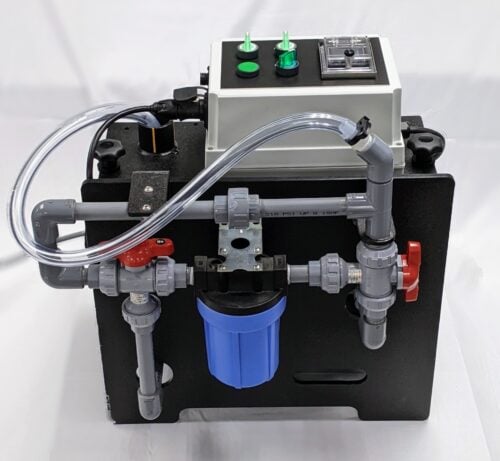
The units are designed to work with SIFCO Process® solutions that are best plated at an elevated temperature. The TechnoFlow 600 can hold over seven liters of solution, while the 1200 unit has a solution capacity of up to 12 liters. Both sizes contain no fuses and have internal circuit breakers as well as 24-volt finger-safe switches meeting UL and CE requirements.
One of the major improvements is the pump adapter plate providing better access to the frame mounting screws, making removing the large 14 GPM pump easier. Improvements have also been made to the pump connector plugs. The new twist lock system guarantees a safe power connection, yet easy removal when needed. Lastly, the TechnoFlow is now equipped with CPVC plumbing lines – providing both sizes a bypass filter – allowing technicians to change the filter mid-operation for large applications.
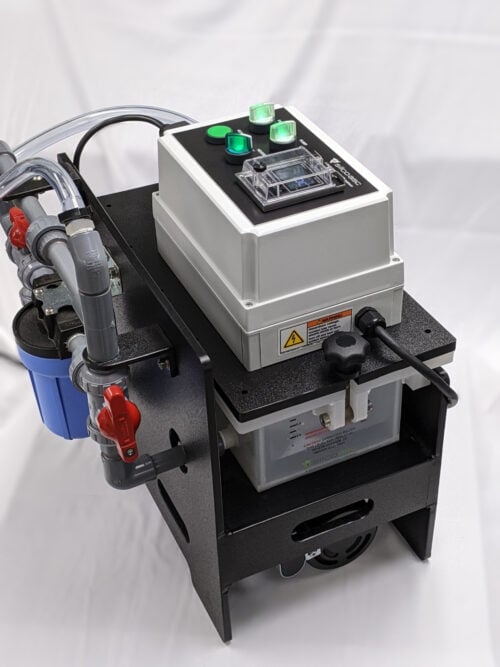 SIFCO ASC’s Engineering Manager, Derek Kilgore, said: “As well as making the overall electroplating process more efficient and user friendly, we wanted to improve the safety features for operators, such as lids with an o-ring seal to decrease solution splash. The system is now equipped with a PID temperature controller with auto-tuning functions, resulting in less overshoot of the set temperature and has the ability to log temperatures throughout the operation for post plating review.”
SIFCO ASC’s Engineering Manager, Derek Kilgore, said: “As well as making the overall electroplating process more efficient and user friendly, we wanted to improve the safety features for operators, such as lids with an o-ring seal to decrease solution splash. The system is now equipped with a PID temperature controller with auto-tuning functions, resulting in less overshoot of the set temperature and has the ability to log temperatures throughout the operation for post plating review.”
The TechnoFlow has recently been incorporated into SIFCO ASC’s new all-in-one plating system featuring dripless technology called the Advanced Solution Control System (ASCS).
As the world leader in selective plating technology, SIFCO ASC has been providing practical, cost-effective brush plating solutions for both OEM components and parts requiring refurbishment in the aerospace, oil and gas, general industry, and power generation sectors for over 50 years.
About SIFCO ASC
SIFCO Applied Surface Concepts provide practical, cost-effective selective brush plating solutions to improve part performance and reduce manufacturing costs through corrosion protection, increased wear resistance, increased hardness, improved conductivity, anti-galling, or slip.
SIFCO ASC surface enhancement technologies and brush plating services have been utilized for over 50 years on both OEM components and parts requiring refurbishment in the aerospace, oil and gas, general industry, and power generation sectors. www.sifcoasc.com
About Quaker Houghton
Quaker Houghton is the global leader in industrial process fluids. With a presence around the world, including operations in over 25 countries, our customers include thousands of the world’s most advanced and specialized steel, aluminum, automotive, aerospace, offshore, can, mining, and metalworking companies. Our high-performing, innovative and sustainable solutions are backed by best-in-class technology, deep process knowledge and customized services. With approximately 4,700 employees, including chemists, engineers, and industry experts, we partner with our customers to improve their operations so they can run even more efficiently, even more effectively, whatever comes next. Quaker Houghton is headquartered in Conshohocken, Pennsylvania, located near Philadelphia in the United States. Visit www.quakerhoughton.com to learn more.
Localized Transmission Case Repair Salvages Critical Component
The job of any vehicle’s transmission is to change gears to ensure the engine’s RPM’s are kept low (depending on speed and acceleration). When the vehicle’s transmission is in working order, fuel consumption is decreased, and the turning of the gears does not overload the engine.
With unpredictable environments and severe conditions, off-highway vehicle transmissions are put to the test every day in the mining industry. And when an off-highway vehicle is out for repair, it puts the operation and future revenues in jeopardy. This unfortunately was the case for the largest coal mining operation in Kalimantan, Indonesia.
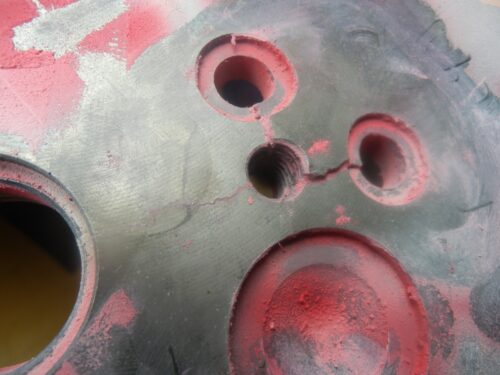
While a vehicle was out for repair, the transmission case was dismantled incorrectly causing cracks and damage to the surface. This company could have used spot welding to repair and fill these cracks, but the risk of additional cracks and heat distortion was too high. Familiar with brush plating, they approached PT Rep Sal Indo, a SIFCO ASC partner in Jakarta, Indonesia to determine if the SIFCO Process® of selective plating was an option.
Selective plating, or brush plating as it’s known, is a portable method of electroplating localized areas without the use of an immersion tank. Its portability allows component repairs and OEM enhancements to happen in-situ with minimal masking and disassembly. The process is also 60 times faster than tank plating, allowing for operations to be completed within one working shift.
The area of repair on the transmission case was 356 x 620 mm (14 x 24.5 inches) and required Copper 2050 to fill defected areas, and a cap of Nickel 2080 for wear resistance. First, PT Rep Sal Indo pre-ground the surface to remove any high spots. The cracks were then filled by laser welding, after which a copper topcoat was applied. The copper was then dressed back to ensure it was flat across the entire surface. Finally, the area was capped with nickel.
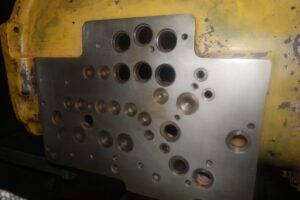 With the use of selective plating, the company was able to salvage the part, saving a considerable amount of cost that would come with replacing the transmission case. What’s more, is the repair was completed within its regular maintenance schedule and the vehicle was back in operation without any additional downtime.
With the use of selective plating, the company was able to salvage the part, saving a considerable amount of cost that would come with replacing the transmission case. What’s more, is the repair was completed within its regular maintenance schedule and the vehicle was back in operation without any additional downtime.
In-situ Repair Maintains Critical Alignment
As with many machines, alignment of gears and components is critical. So, when even one component becomes out of round or out of tolerance, it can jeopardize not just the machine, but the entire operation with the threat of downtime and costly repairs.
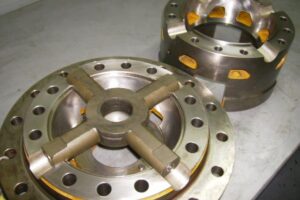 Unfortunately, the largest coal mining operation in Kalimantan, Indonesia, experienced just this situation when a differential bearing housing became out of round from the relentless production required by the mining industry. But repairing this bearing housing isn’t as easy as it seems. They could build up the area with thermal spray, however this process is time consuming and comes with a high risk of mis-machining due to the critical alignment of the differential gear during assembly.
Unfortunately, the largest coal mining operation in Kalimantan, Indonesia, experienced just this situation when a differential bearing housing became out of round from the relentless production required by the mining industry. But repairing this bearing housing isn’t as easy as it seems. They could build up the area with thermal spray, however this process is time consuming and comes with a high risk of mis-machining due to the critical alignment of the differential gear during assembly.
So, this coal mining company reached out to PT Rep Sal Indo, a SIFCO ASC partner based in Jakarta, Indonesia, specializing in the SIFCO Process® of selective electroplating. The SIFCO Process® is a portable method of electroplating localized areas without the use of an immersion tank. The use of handheld anodes allows technicians to mask off the specific areas to be plated, and apply the deposit in-situ, with minimal disassembly. Such was the case with the Differential Bearing Housing. By using selective plating, the repair was able to be completed with the gears installed, fully preventing the risk of misalignment. PT Rep Sal Indo fully repaired 2 internal diameters within 0.025mm – meeting the customer’s required specifications and significantly reducing potential downtime.
Restoring Tolerance to Wheel Hub Bolt Holes
Off highway vehicles face demanding environments. And every component of that vehicle is essential.
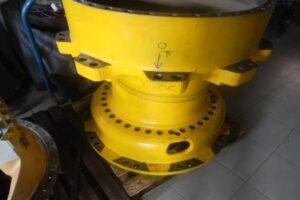 For the largest coal mining operation in Kalimantan, Indonesia, that critical component was a wheel hub assembly. The wheel hub assembly allows the vehicle to steer freely, and is critical to the anti-lock braking and traction control systems. But when a tire is changed, often multiple times as in the mining industry, the bolt holes become worn and oversized – not allowing the bolt shank to retain its position.
For the largest coal mining operation in Kalimantan, Indonesia, that critical component was a wheel hub assembly. The wheel hub assembly allows the vehicle to steer freely, and is critical to the anti-lock braking and traction control systems. But when a tire is changed, often multiple times as in the mining industry, the bolt holes become worn and oversized – not allowing the bolt shank to retain its position.
So, when 18 bolt holes of the wheel hub assembly needed resized, there was only a couple of options – electroplating or welding and machining. Build up by welding and machining, however, requires complex equipment, extensive downtime, and potential heat distortion and mis-machining. Electroplating, on the other hand, has no risk for heat distortion and can be plated to size. But, since tank plating was not an option due to the masking required to protect the rest of the component, they decided to contacted P.T. Rep Sal Indo, a SIFCO ASC partner in Jakarta-Indonesia who specializes in the SIFCO Process® of selective plating.
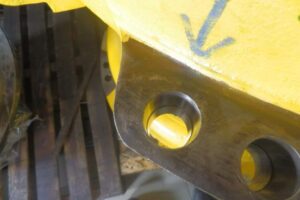 Selective plating is the portable method of electroplating and is used to apply electroplated deposits and anodized coatings in localized areas of a part without the use of an immersion tank. By using the SIFCO Process®, P.T. Rep Sal Indo was able to restore dimension to 18 bolt holes, by first building up the area with Copper 2050, then capping the holes with Nickel 5644 for wear resistance. The total internal dimension of bore was plated within 0.02mm of the required thickness.
Selective plating is the portable method of electroplating and is used to apply electroplated deposits and anodized coatings in localized areas of a part without the use of an immersion tank. By using the SIFCO Process®, P.T. Rep Sal Indo was able to restore dimension to 18 bolt holes, by first building up the area with Copper 2050, then capping the holes with Nickel 5644 for wear resistance. The total internal dimension of bore was plated within 0.02mm of the required thickness.
Mining companies will continue to face the everyday challenge of wear and tear on their machinery, therefore forcing them to reduce costs through rebuilding and remanufacturing their critical components. With the use of the SIFCO Process® these components can be restored to their OEM standards with superior adhesion and minimal downtime – helping mining companies move forward towards more continuous, cost-efficient and sustainable operations.

 Chinese (Simplified)
Chinese (Simplified)  English
English  French
French  German
German  Spanish
Spanish  Swedish
Swedish 